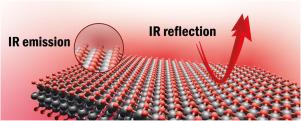碳氮比作为碳氮化物MXenes红外特性调整的杠杆
IF 9.7
2区 材料科学
Q1 MATERIALS SCIENCE, MULTIDISCIPLINARY
引用次数: 0
摘要
MXenes在红外(IR)范围内表现出广泛的特性,要么是红外光的高效热辐射体,要么是高反射性的,类似于抛光金属。可调的红外反射率与MXenes独特的物理和化学特性(如低导热性和高效的光热转换)相结合,为一系列应用提供了机会。然而,人们需要知道元素组成的影响,特别是碳和氮含量,以获得满足特定应用需要的红外性能。本研究通过改变四种不同成分(2C:0N, 1.75C:0.25N, 1.5C:0.5N和1C:1N)的碳氮比,研究了碳氮化钛MXenes性能的可调性。多种实验表征技术,包括x射线衍射(XRD)、傅里叶变换红外光谱(FTIR)、拉曼光谱和热发射率测量,结合密度泛函理论(DFT)计算,了解C/N比对红外性能的影响。研究表明,碳氮比显著影响MXenes在1 ~ 25μm25μm范围内的红外响应。较高的碳含量增强了红外反射率,支持卓越的热管理和红外隐身,而增加的氮含量提高了发射率并改变了声子吸收带。这些发现表明,碳氮比调制可以精确调节碳氮化钛MXenes的红外特性,使其成为热管理、传感和多光谱电磁屏蔽应用的有前途的材料。本文章由计算机程序翻译,如有差异,请以英文原文为准。


The C/N ratio as a lever for infrared properties tuning in carbonitride MXenes
MXenes have demonstrated a broad range of properties in the infrared (IR) range being either efficient thermal emitters of IR light, or highly reflective, similar to polished metals. A combination of tunable IR reflectivity with the unique physical and chemical properties of MXenes, such as low thermal conductivity and efficient light-to-heat conversion, offer opportunities for a range of applications. However, one needs to know the effect of elemental composition, particularly carbon and nitrogen content, to obtain IR properties meeting the needs of specific applications. This work investigates the tunability of properties in titanium carbonitride MXenes by varying their carbon-to-nitrogen ratio across four distinct compositions (2C:0N, 1.75C:0.25N, 1.5C:0.5N, and 1C:1N). Multiple experimental characterization techniques, including X-ray diffraction (XRD), Fourier-transform infrared spectroscopy (FTIR), Raman spectroscopy, and thermal emissivity measurements, were combined with density functional theory (DFT) calculations to understand the influence of C/N ratio on infrared properties. The study reveals that the C/N ratio significantly affects the IR response of MXenes in the 1- range. Higher carbon content enhances IR reflectance, supporting superior thermal management and IR stealth, while increased nitrogen content elevates the emissivity and alters the phonon absorption bands. These findings demonstrate that C/N ratio modulations enable precise tuning of IR properties in titanium carbonitride MXenes, making them promising materials for thermal management, sensing, and multispectral electromagnetic shielding applications.
求助全文
通过发布文献求助,成功后即可免费获取论文全文。
去求助
来源期刊

Materials Today Physics
Materials Science-General Materials Science
CiteScore
14.00
自引率
7.80%
发文量
284
审稿时长
15 days
期刊介绍:
Materials Today Physics is a multi-disciplinary journal focused on the physics of materials, encompassing both the physical properties and materials synthesis. Operating at the interface of physics and materials science, this journal covers one of the largest and most dynamic fields within physical science. The forefront research in materials physics is driving advancements in new materials, uncovering new physics, and fostering novel applications at an unprecedented pace.
 求助内容:
求助内容: 应助结果提醒方式:
应助结果提醒方式:


